General. Later, geriatric and general OPD
The Croydon General Hospital opened as a voluntary hospital in 1867 in a part of the old infirmary vacated by the workhouse, which had moved to Queens Road. It had 14 beds.
By 1869 it was reported at the second Annual Meeting that the Hospital had a balance of £152 in hand after all expenses had been paid. The Hospital was partially self-supporting; in-patients paid 3s (15p) a week, while out-patients paid 6d (2.5p) a week while under treatment. Four free beds were available for a limited number of deserving cases from the poor industrial classes. The cost of for the purchase of these beds and related furniture - £27 18s 3d (£27.92) had been defrayed by the generosity of four governors.
After a few years larger premises were needed and, because the Hospital was under a brief lease, it was planned to erect purpose-built premises elsewhere in Croydon. Two pieces of land were eligible and eventually, in 1873, Oakfield Lodge, a mansion in London Road with 3.37 acres of grounds, was purchased. It was decided to keep the Lodge and, after considerable alterations, the 3-storey building was officially opened in September 1873 by the Archbishop of Canterbury. The Hospital had 30 beds. The large garden in the grounds provided fruit and vegetables for the patients and staff.
The Hospital was enlarged in 1883, when the Royal Alfred Wing was built, the foundation stone having been laid by the Duke of Edinburgh.
In October 1894 another new wing was opened by the new Archbishop of Canterbury.
In the early 20th century the Hospital was further extended southwards and, following a public appeal for funds initiated by the Mayor of Croydon, Alderman J. Trumble, extended northwards as a memorial to King Edward VII. In 1912 the Mayor and Mayoress opened the King Edward Memorial Wing and the extensions to the Royal Alfred Wing. In the same year X-ray, Electrical and Massage Departments were established.
The original Hospital building stood back from London Road, which at that point ran north by northwest. The administration block in the centre was parallel to the road, with the X-ray Department behind it. The Casualty Department with wards above it were at the north end. The Royal Alfred Wing, containing Mark and Mary Wards, each with 28 beds, was behind the south end of the administration block. The Edward Memorial Wing with Luke and Edridge Wards, also with 28 beds each, lay to the south, opposite the main entrance. The southeast part of the site contained the lawns and the kitchen garden of the old mansion house.
During WW1 two wards were made available for wounded servicemen. The 50 beds were rarely empty. There were few local civilian air-raid casualties, apart from a fatal Zeppelin attack in October 1915, but the Hospital served a wide area, with patients coming from Streatham and Purley. Most suffered shrapnel wounds, having been caught out in the street during the barrage.
In November 1916 the King and Queen visited Croydon and its hospitals.
The Census in 1921 showed that 33,000 people in employment lived in the Borough of Croydon, but over 28,000 worked in London. This meant that their health insurance contributions were paid in London, not Croydon, with the result that the Borough did not receive its fair share, causing financial difficulties to the Hospital.
In 1924 Artifical Sunlight and Remedial Exercise Rooms were installed and, in the following year, orthopaedic and fracture clinics were established.
In 1926 the foundation stone for an new Out-Patients Department and a ward extension to the south wing was laid by Prince George. The President of the Hospital, the Archbishop of Canterbury, performed the opening ceremony in June 1927, with the King and Queen in attendance, in the presence of 200 people. The new buildings and their equipment had cost £75,500. The Out-Patients Department faced London Road, with a small courtyard between it and the Casualty and X-ray Departments. At the northeast of the site were the pathology laboratories, the laundry and the mortuary.
The Archbishop appealed for funds to build a new Nurses' Home. A private patients' block was also needed. He stated that the Hospital was in an unfortunate position, being regarded as being in London by people living in rural areas, and as being almost in the country by those living in London. Thus, Croydon's needs were not appreciated, to the disadvantage of the Hospital.
By the beginning of the 1930s the Hospital had 130 beds, a Casualty Department and an Out-Patients Department with medical, surgical, ophthalmic, ENT, skin and dental clinics. The large Out-Patients Department, with its specialist clinics not found in the smaller hospitals, attracted patients from a large area (the neighbouring Norwood Hospital and Purley War Memorial Hospital had no out-patient facilities, while the 400-bed municipal Mayday Hospital limited its Out-Patients Department to its own discharged in-patients).
Because 50% of the Hospital's in-patients were referred from outside the Borough, the local GPs had difficulties in getting beds for their patients. They sent them instead to the Mayday Hospital, which restricted admissions only to residents of the Borough of Croydon.
In February 1932 the Charles Heath Clark Memorial Nurses' Home opened. The Home was a conversion of three houses - Nos. 14, 16 and 18 Lennard Road - owned by the Hospital on the opposite side of Lennard Road (No. 18 had already been in use as a Nurses' Home). The one detached house was extended and the space between it and the two semi-detached houses was filled in. The new Home had 50 bedrooms for nurses on the ground, first and second floors, and 3 maids' bedrooms in the attics. (The current number of nursing staff was 36, but should have been 40). On the lower ground floor were a large sitting room and recreation room, a study and a Lecture Room. The funds for the building had been provided by Mr Charles Heath Clark, J.P., who had bequeathed £430,000 to the Hospital. The Chairman of the Hospital Board of Management, Sir Herbert Brown, donated £2,500 to the project.
The bequest was also used to improve the Hospital kitchens and laundry, and to build an extension which could accommodate 60 beds, including 17 for private patients. An Appeal was launched to raise more money.
The new extension was officially opened in June 1934 by the Duchess of York (who later became Queen Elizabeth, the Queen Mother). A gift of £1,500 from Lt. Col. Garwood enabled the building to open debt-free (it had cost £34,000, including furnishings and fittings). The Hospital then had 200 beds (including for 23 private patients). At this time the average length of stay of an in-patient was 17 days.
In 1935 the Nurses' Home was extended, when the house next-door (No. 12) was purchased. The Solarium in the 18-bedded children's ward was also extended. In June 1935 Prince George laid the foundation stone for a new ward pavilion at the south of the site. The two new wards each contained 14 beds. Verandahs at the end of the building each provided permanent accommodation for 6 more beds, and each ward had a 2-bedded isolation ward. The building also contained 7 single rooms, two 2-bedded rooms and two 3-bedded rooms for private patients.
By 1935 the average cost of an in-patient per week was £2 19s 9d (£2.99p) (compared with £3 9s 4d (£3.46p) in 1934). In 1936 it was £3 0s 9d (£3.04p) and, in 1937, £3 7s 0d (£3.35p). The average stay of an in-patient was 18.5 days.
At the outbreak of WW2, in September 1939, the Out-Patients Department was closed. During the war, the peacetime complement of 200 beds was increased to 233, and later to 250 (of which 110-127 were EMS beds - only 10% of which were ever occupied at one time). In 1938 of the 183 beds available, only 164 were occupied. By 1944 only 116 of the 243 available beds were occupied.
In 1944 Croydon had the dubious honour of being the most bombed Borough in the country, placing a serious strain on its health services.
After the war the Out-Patients Department reopened and the Hospital's bed complement reverted to 200, of which 45 were EMS beds.
The Hospital joined the NHS in 1948 under the control of the Croydon Group Hospital Management Committee, part of the South West Metropolitan Regional Health Board.
In the same year Wickham House in Lennard Road was converted into accommodation for night nurses. The building had originally been bought for use as a Preliminary Training School for Nurses, but this was established instead in the new Nurses' Home. In 1945 the Board of Management had wanted to make it a maternity annexe, but the Ministry of Health refused permission on the grounds that it was unsuitable. The Board then planned to make it a Night Nurses' Home, but Croydon Corporation used it to house families made homeless by the war. The Corporation intended to turn the house into three flats but were unable to because of the post-war building restrictions. In the event, the Hospital regained control of the building, spending £10,000 on its conversion.
A programme of modernisation began in the 1950s. In 1953 a new cafeteria was built (in 1959 a two-course lunch cost 2s 1d - about 10p).
In 1957 the wards were modernised and officially opened by Princess Alexandra. The Hospital had 200 beds for acute patients.
During the 1960s Lennard Lodge was built in Lennard Road, at the back of the Hospital, as a Sisters' Home.
By 1963 the Accident & Emergency Department was deemed to be cramped and in need of more staff. Improvements were made, but the intention was to close the Department and its services to be transferred to the Mayday Hospital.
By 1986 the Hospital had 97 beds.
With the expansion of the Mayday Hospital, services began to be run down.
The Hospital finally closed to patients in 1996, but a few administrative offices remained in its grounds.
Present status (March 2008)
The Hospital was demolished in 2004, at a cost to the South London and Maudsley NHS Trust (SLaM) of about £800,000. Plans had been made to redevelop the site in partnership with the Croydon Voluntary Action (CVA) organisation to provide 16 1- and 2 bedroomed social-rented and shared-ownership apartments. There would also be a variety of community facilities which would be owned and managed by CVA. A healthcare centre was also planned, which would be occupied by departments run by SLaM, Croydon Primary Care Trust, Croydon Social Services and the CVA.
In 2004, however, the CVA and Croydon Social Services withdrew from the project on financial grounds.
Planning permission was given to the Metropolitan Housing Trust in 2005 to use part of the site for an environmentally friendly housing development. The Croydon Healthy Resource Centre, with facilities for the local community and 16 apartments, opened in 2008.
Update (October 2010)
The 3.27 acre site remains a barren buildng site, although the Nurses' and Sisters' Homes in Lennard Road remain.
In 2010 there have been suggestions to Croydon NHS Trust that the land be used as a park until redevelopment begins.

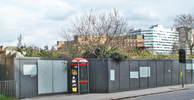
The boarded-up entrance gates of the Hospital.
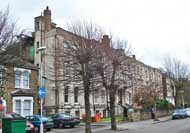
The Nurses' Homes in Lennard Road.
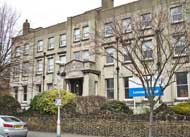
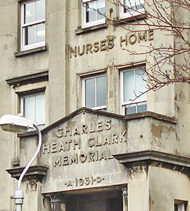
The Nurses' Home now belongs to Croydon NHS Primary Care Trust (left). The building still bears the legend 'Nurses' Home' and 'Charles Heath Clark Memorial 1931' above the main entrance (right).
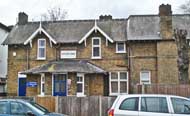
Lennard Lodge, once the Sisters' Home, is now the Lennard Lodge Child and Family Clinic.
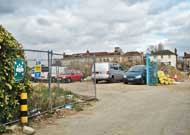
The razed site which may become a temporary park.
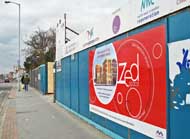
Blue fencing with an advertisement for the new housing project - the Croydon Healthy Resource Centre - to be built at 80 London Road.
Update: October 2010
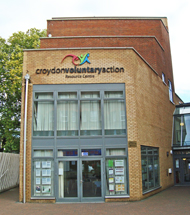
The Croydon Voluntary Action building, part of the Croydon Healthy Resource Centre, which was completed in 2008.
Addington Palace became a military hospital during WW1 - Addington Park War Hospital.
(Author unstated) 1869 Title. British Medical Journal 2 (X), 4th Sept, 273.
(Author unstated) 1912 Title. British Journal of Nursing, 27th July, 74.
(Author unstated) 1916 Title. British Journal of Nursing, 4th November, 370.
(Author unstated) 1927 The Croydon General Hospital. British Journal of Nursing, July, 171.
(Author unstated) 1932 The Croydon General Hospital. British Journal of Nursing, March, 64-65.
(Author unstated) 1934 Visit by the Duchess of York to the Croydon General Hospital. British Journal of Nursing, July, 189.
(Author unstated) 1932 Title. British Journal of Nursing 30, 311-312.
Bligh S 1994 Croydon in Old Photographs. Stroud, Alan Sutton Publishing Co.
http://generalpractitionermemorials.blogspot.com
http://hansard.millbanksystems.com
www.croydon.gov.uk
www.croydonguardian.co.uk
www.croydononline.org
www.derelictplaces.co.uk
www.flickr.com
www.mhp-online.co.uk
www.pmg.ie
www.theyworkforyou.com (1963)
www.theyworkforyou.com (1964)
www.thisiscroydontoday.co.uk
www.uer.ca
Return to home page